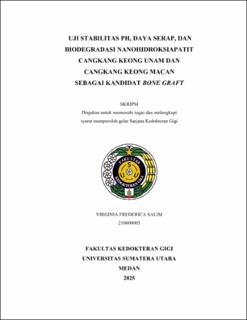Uji Stabilitas pH, Daya Serap, Biodegradasi Nanohidroksiapatit Cangkang Keong Unam dan Cangkang Keong Macan sebagai Kandidat Bone Graf
Stability Test of pH, Swelling, and Biodegradation of Nano-Hydroxyapatite from Unam Snail Shell and Tiger Snail Shell as Bone Graft Candidates

Date
2024Author
Salim, Virginia Frederica
Advisor(s)
Nasution, Aini Hariyani
Metadata
Show full item recordAbstract
Nano-hydroxyapatite is a bioactive material used in dental applications, particularly as a bone graft candidate for alveolar bone regeneration. This study aimed to examine the differences in pH stability, swelling, and biodegradation of nano-hydroxyapatite synthesized from Unam snail shell (Volegalea cochlidium) and Tiger snail shell (Babylonia spirata). The type of research used was a pre-experimental laboratory research with a one-shot case study design. The research samples consisted of Unam and Tiger snail shells processed into nano-hydroxyapatite through the sol-gel method, followed by testing. The tests included pH stability analysis in physiological solutions, swelling through immersion in buffer saline solution, and biodegradation using simulated body fluid. The results showed significant differences between the nano-hydroxyapatite from Unam and Tiger snail shells in terms of pH stability and swelling, while the differences in biodegradation values are not significant. Unam snail shells are superior in swelling test and pH stability, while Tiger snail shells exhibit more stable biodegradation properties. The conclusion of this study indicates that both materials have potential as bone graft candidates, ach with its own advantages.
Collections
- Undergraduate Theses [1910]
